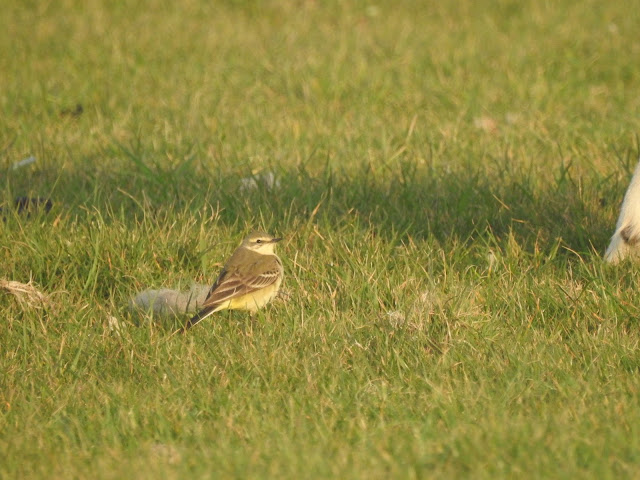Bird Observatory Warden Stuart reviews an excellent week of migration on the island.
A light southeasterly
to start the week was followed by three days of strong easterlies. Moderate
east and southeast winds blew on 21st and 22nd and the 23rd was a very light
northerly. The week was mostly dry with rain towards the end of the week.
Two pairs of Teal were seen on Pondsbury this week. Two Shelduck were on Pondsbury on 22nd. The third island record of Great White Egret was found on Pondsbury by visiting young birders on 17th and was still present on the morning of 18th. The first Collared Dove of the year appeared on 18th and was joined by a second on 19th. They were both seen up to the 23rd. A Stock Dove was seen on 23rd and unusually a flock of 13 Woodpigeon were counted in Quarter Wall Copse. The first Cuckoo of the year was up by Old Light on 18th.
 |
| Great White Egret, Pondsbury © Stuart Cossey |
 |
| Shelduck, Pondsbury © Stuart Cossey |
It was an excellent week for wader migration. The island’s 7th record of Little Ringed Plover was heard and then seen with a Ringed Plover and two Dunlin in Lighthouse Field on 20th. It was then heard calling on the evening of the 21st. Five Purple Sandpiper were still at Brazen Ward on 19th. Whimbrel were seen on five dates including two on 20th, 22nd and 23rd. Ringed Plover were seen or heard on six dates with two on 18th and 23rd. Three Dunlin were seen on 18th and two on 20th and 21st. A late Jack Snipe was seen on the evening of 21st. Three Common Sandpiper were around Rat Island on 21st.
 |
| Little Ringed Plover, Lighthouse Field © Luke Marriner |
 |
| Dunlin, Lighthouse Field © Stuart Cossey |
 |
| Whimbrel, South West Field© Stuart Cossey |
 |
| Common Sandpiper, Rat Island © Stuart Cossey |
Jenny’s Cove is getting busy with 559 Guillemot, 469 Razorbill
and 93 Puffin counted on 21st. Other
than our breeding seabirds, a Black-headed
Gull was seen on 22nd and a Mediterranean
Gull flew past on 19th. A Sandwich Tern was in the Landing Bay on 23rd. A Great Northern Diver was still present in the Landing
Bay on 17th.
The wintering female Sparrowhawk
was last seen on 20th and the Merlin
on the 17th. The pair of Kestrel are
regularly being seen along with Peregrines.
A Marsh Harrier flew over the island on
17th.
The overnight fog and calm winds made for a superb day of migration on 17th. Totals include 500 Willow Warbler, 74 Chiffchaff, four Reed Warbler, 12 Grasshopper Warbler, five Sedge Warbler, 300 Blackcap, three Whitethroat, a Firecrest and six Goldcrest. After a full day of ringing in Millcombe a total of 402 birds were processed. Birds cleared out overnight with reduced numbers the rest of the week with 50 Willow Warblers on 18th and 56 on 22nd. Nine Sedge Warblers were present on 22nd along with Reed Warblers on 18th, 21st and 22nd. Up to three Grasshopper Warblers were recorded most days for the rest of the week. A late Siberian Chiffchaff was ringed in Millcombe on 23rd.
 |
| Reed Warbler, Millcombe © Danielle Carbott |
There was a small pulse of thrush migration. Ring Ouzel were recorded between 17th and 22nd with a maximum of 12 on
18th, five on 21st and four on 19th and 20th. Six Song Thrush were
recorded on 21st including our resident singing male.
 |
| Ring Ouzel, West Side © Stuart Cossey |
The first Spotted
Flycatcher of the year was seen on
22nd. Nine Pied Flycatcher were counted on 17th with three on the 21st. Two were
present on 18th and 23rd and singles on 20th and 22nd. A Black Redstart was seen
on 17th and 18th and up to 12 Common
Redstart were seen on 17th. Other
high counts include five Redstart on
18th and six on 21st. A male Whinchat
was on the Terrace on 20th. Obvious passage of Wheatear was noted across the plateau. Over 80 were seen on 18th,
21st and 22nd with the majority being the larger and brighter Greenland race.
 |
| Pied Flycatcher, Barton Field © Reuben Veal |
 |
| Greenland Wheatear, South West Field © Stuart Cossey |
 |
| Greenland Wheatear, South West Field © Stuart Cossey |
The male Blue-headed
Wagtail was seen again on 17th along with two other Yellow Wagtail. A single female was seen on 21st. Up to four White Wagtail were seen during the week and there was a high count of 16 alba wagtail
on 17th.Five Tree Pipit were also noted on 17th with one
on 18th, three on 20th and 22nd and four on 21st.
 |
| Yellow Wagtail, Lighthouse Field © Stuart Cossey |
 |
| Blue-headed Wagtail, Barton Field © Reuben Veal |
A Serin flew along the West Side with three Goldfinch on 20th. Two Greenfinch were seen on 23rd and a Siskin was seen on 17th. Single Lesser Redpoll were counted on 17th and 21st. A high count of 35 Goldfinch were counted on 17th. 196 Linnet were counted on 23rd, 183 on 21st and 135 on 17th.
In non-avian news, a Painted
Lady and Peacock were seen on 17th and a Red Admiral on 20th.
Contributors: Stuart Cossey, Luke Marriner, Rosie Ellis, Chris
Dee, Rackie Powell, Rob Duncan, David Kightley, Rueben Veal, Harry Hiscox, Will
Pearce, Jake Belton, Ellie Holley, Danielle Austin, Henry Pagem Owen Davies,
Sian Davies, Beth Newark, Iona Cunningham-Eurich, Stephan Cheung, Nathan
Williams, Alex Liddle
















